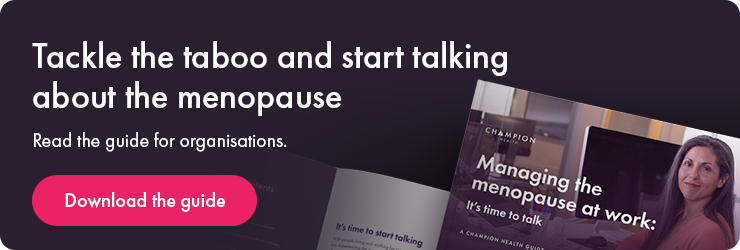With people living and working for longer, women experiencing the menopause are the fastest-growing demographic in the workplace.
Despite this, discussing the menopause in the workplace is still seen as taboo, which prevents many of your key employees from getting the support they need.
The effects of the menopause can be extremely debilitating, with almost 1 million women leaving their jobs because of the menopause, according to BUPA.
Many of these women are at the top of their game professionally, so not only are these organisations failing to support their employees, they are also losing top talent unnecessarily.
This means that supporting these employees should be at the top of the business agenda for your organisation.
As a manager or a leader in your organisation, use this guide to take on the taboo, by stimulating conversation around the menopause at work and providing effective support to employees experiencing it.
In this guide, you’ll discover:
- What managers need to know about the menopause
- What are the symptoms of the menopause?
- How can organisations support employees experiencing the menopause?
Looking for something you can download? We’ve also put this key information together into a free guide: Managing the Menopause at Work: It’s Time to Talk.
Are you looking for support for yourself? If so, read our guide on how to work during the menopause.
What managers need to know about the menopause
Information and education are vital to address any workplace challenge, so use this section to discover some of the key information surrounding the menopause.
The menopause usually occurs between the ages of 45 and 55, with an average age of 51 in the UK. However, this can vary between women, depending on genetic and lifestyle factors.
The amount of time the menopause lasts varies. On average, it’s around 4 years in total, but 1 in 10 women experience menopause symptoms for up to 12 years.
Symptoms usually start a few years before a woman’s period stops (known as the perimenopause) and can continue for some time after.
What are the symptoms of the menopause?
As humans, our genetic composition varies, so one person’s experience of the menopause is not always identical to others.
Research suggests that 80% of women experience some noticeable symptoms, so – although it might seem like it – anyone experiencing the menopause is not going through it alone.
During the transition phase, the first symptom an individual may experience is a change to their menstrual cycle, such as their period arriving late or changing in intensity.
Due to the decline of oestrogen, they may also experience symptoms such as irritability, trouble sleeping, hot flushes and night sweats – the latter can further contribute to a poor night’s sleep.
Other common symptoms include a drop in sex drive, vaginal dryness or pain and discomfort during sex.
Memory problems are also common during the menopause. This is associated with a decline in testosterone, resulting in “brain fog” that impairs memory and concentration.
It can also influence mood and increase levels of tiredness. Experiencing all these symptoms can make work very difficult, leading to 1 in 4 women considering resigning from their jobs due to experiencing menopausal symptoms.
How can organisations support employees experiencing menopause in the workplace
With 3.5 million working women aged 50 and over in the UK, you’re likely to have someone in your organisation who is currently experiencing the menopause.
As a people manager you need to ensure that any employee experiencing the menopause is provided the same support and understanding that they would get if they had any other health issue.
Discover three ways that your organisation can support employees who are experiencing the menopause below.
1. Promote understanding
The most important aspect of menopause support is understanding – creating a culture where everyone is menopause-aware.
I always say that sometimes employees just need to know that they can talk about the menopause without being embarrassed.
For an in-depth look at this topic, read this guide on building menopause awareness in the workplace, where we discuss tips like:
- How to maintain an open dialogue around the menopause
- Training and classes
- Informal support groups
2. Train your line managers
Line managers will often be the first people who employees experiencing the menopause will talk to – so make sure they’re ready, willing and able to help.
As a starting point, ensure that every line manager is aware of:
- How the menopause affects employees
- The different adjustments that may be necessary to support an employee who is experiencing the menopause (more on that below)
- The available internal and external support services, that employees can be signposted towards. Some excellent resources include:
3. Make the necessary adjustments
Once you understand the challenges that an employee is facing, the next step is to make the changes that enable them to continue working at their best.
On average, someone going through the menopause experiences a combination of 9 different symptoms, so it’s likely they’ll need different adjustments to be made at different times.
CIPD recommend adopting a “cafeteria approach”, where employees can choose from a range of different adjustments to suit their specific symptoms.
Here are nine adjustments you could make to help an employee who is experiencing the menopause:
- Offer flexible working hours, including later start times or permission to leave at short notice
- Provide access to a quiet and private working space
- Give employees the option to work from home
- Offer easy access to cold drinking water
- Cool the working environment, for example by providing a fan, moving a desk close to a window or adjusting the air conditioning
- Provide easy access to washroom and toilet facilities
- Allow time off to attend medical appointments that are menopause-related
- Agree some protected time when employees can catch up with any work that is missed due to difficulties caused by the menopause
- Identify a supportive colleague to talk to away from the office, such as a designated wellbeing champion or menopause expert
We’ve also detailed adjustments women in your organisation might request when talking about the menopause. Read this article on how to work through the menopause for more information.
Menopause in the workplace: It’s everybody’s responsibility
Menopause in the workplace does not just affect half of us. Everyone can be affected by the menopause in some way, so everyone needs to know about it, and how to support someone experiencing it.
By supporting employees who are going through the menopause, organisations can help every employee perform to their best, while feeling supported and understood.
It’s time for every organisation to take on the taboo and start talking about managing the menopause at work.





